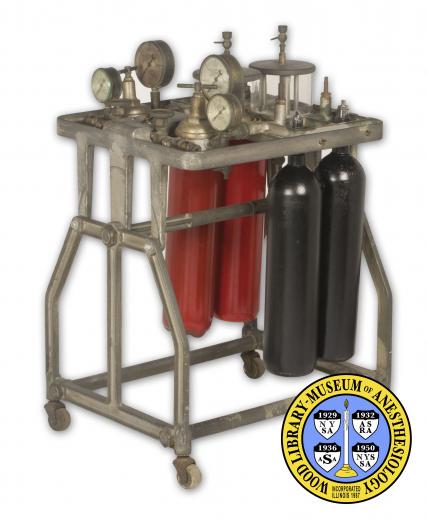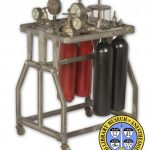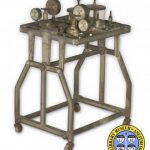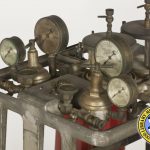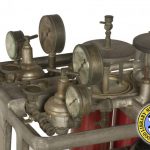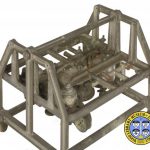Cotton & Boothby Apparatus
Dr. Frederic J. Cotton (1869-1938) and Dr. Walter Boothby (1880-1953) were colleagues at the Boston City Hospital when they developed this apparatus for nitrous oxide-oxygen-ether anesthesia. They wanted a device that could provide an uninterrupted flow of anesthetics and oxygen, a visible indication of the rate of flow for both the nitrous oxide (N2O) and oxygen (O2), and the means to quickly and easily add ether vapor to the gas mixture. Their solution for estimating the flow rate was to pass each gas separately through water in a glass mixing chamber. The rate of bubbling of the gases through the water was used to estimate the flow and proportion of each gas. After the N2O and O2 exited the first mixing chamber, a portion could be directed into a second mixing chamber, which held ether. The gases directed into the ether chamber could be made to pass over the surface of the ether or bubble through it. The gases could also be directed to fully bypass the ether chamber.
The process of estimating the flow rate of gas by bubbling it through a liquid is commonly referred to as the “bubble bottle” or "bubble-through" method. Its influence can be seen in anesthesia devices developed by others, including those developed by Dr. James Gwathmey (1862-1944) of the United States, and Dr. Henry Boyle (1875-1941) of the United Kingdom. Drs. Frederick J. Cotton and Walter Boothby introduced this apparatus in 1911.
Catalog Record: Cotton & Boothby Apparatus
Access Key: aiwk
Accession No.: IL 1940-1
Title: [Cotton-Boothby apparatus / designed by Frederick J. Cotton & Walter M. Boothby.]
Author: Cotton, Frederic J., 1869-1938.
Author: Boothby, Walter M. 1880-1953.
Title variation: Alt Title
Title: Cotton and Boothby apparatus.
Title variation: Alt Title
Title: Cotton-Boothby gas-oxygen machine.
Publisher: [S.l. : s.n., 1910-1912.]
Physical Description: 1 anesthesia machine : metal, glass, rubber ; 86 x 55 x 45 cm.
Subject: Anesthesia Machines.
Subject: Anesthesia, Inhalation.
Subject: Nitrous Oxide.
Subject: Oxygen.
Subject: Ether, Ethyl.
Note Type: General
Notes: Title based on WLM records; Alternate titles based on WLM records and
references to the apparatus in a number of articles; Date based on WLM
records.
Note Type: Citation
Notes: Cotton FJ. Nitrous oxide-oxygen-ether anaesthesia: notes on administration; a
perfected apparatus. Surg Gynecol Obstet. 1912;15(3):281-289.
Note Type: Citation
Notes: Smith WDA. A history of nitrous oxide and oxygen anaesthesia part xii:
developments in America and Nitrous oxide anaesthesia between world wars. Br
J Anaesth. 1972;44(2):215-221.
Note Type: Citation
Notes: Thompson PW, Wilkinson DJ. Development of anaesthetic machines. Br J Anaesth.
1985;57(7):640-648.
Note Type: Citation
Notes: Vandam LD. Walter M. Boothby, M.D. – the wellsprings of anesthesiology. NEJM.
1967;276(10):558-563.
Note Type: Physical Description
Notes: One anesthesia machine with an open frame on wheels; The apparatus does not
have an obvious front, but for the purposes of this description the side the
user faces when reading the gas gauges will be considered the front; All of
the working parts are situated within the horizontal plane of the top frame
of the apparatus; From front to back, the working parts include an ether
valve in the front center; On each side of the ether valve is a valve, with a
turn knob, to regulate the volume supply of oxygen (on the left) and nitrous
oxide (right); Behind these valves are reducing valves with butterfly
handles; Just to the left of the oxygen (O2) reducing valve and to the right
of the nitrous oxide (N2O) reducing valve are low pressure gas gauges; The
low pressure gas gauges are numbered in increments of 5 from 0 to 30, with
tick marks for every 1 increment; Manufacturer markings on the valves include
“THE BISHOP-BABCOCK [new line] BECKER CO.” and “CLEVELAND [new line] OHIO”;
Just behind the O2 and N2O reducing valves are high pressure gas gauges that
indicate the pressure in the supply tanks; The high pressure gas gauges are
marked in increments of 100, and numbered from 0 to 3000 at increments of
500; In the center, behind and between the two high pressure gas gauges are
two metal and glass mixing chambers; The glass is missing from the forward
mixing chamber; The mixing chamber furthest back would have been filled with
water when the apparatus was in use; The forward mixing chamber was for
ether; On each side of the mixing chambers are two yokes with valves that
allow a tank to be replaced without interrupting the function of the
apparatus; O2 tanks would be on the left side, and N2O tanks on the right; A
central bar that runs horizontally from back to front acts as an axis on
which the top portion of the apparatus swings into an upside-down position;
In this position the mixing chambers are protected by the frame and the
‘axis’ bar acts as a handle for carrying the apparatus.
Note Type: Reproduction
Notes: Photographed by Mr. William Lyle, in the Fall of 2010; In order to present an
image of the apparatus in the best state possible, the apparatus was
photographed with generic gas tanks (or cylinders) from the Parts Collection.
Note Type: Historical
Notes: Frederic J. Cotton, M.D. (1869-1938) and Walter Boothby, M.D. (1880-1953)
worked together at the Boston City Hospital when they developed this
apparatus for nitrous oxide-oxygen-ether anesthesia. In the second article to
describe the apparatus Cotton and Boothby related the objectives that guided
the design of the machine. They wanted a device that could provide an
uninterrupted flow of anesthetics and oxygen, a visible indication of the
rate of flow for both the N2O and O2, and the means to quickly and easily add
any concentration of ether vapor to the gas mixture. Their solution for
estimating the flow rate was to pass each gas separately through water in a
glass mixing chamber. The rate of bubbling of the gas through the water was
used to estimate the flow and proportion of each gas. After the N2O and O2
leave the first mixing chamber they may pass partly or wholly over the
surface of the ether, bubble through the ether, or by-pass the ether chamber
completely. This process of estimating the flow rate of gas by bubbling it
through a liquid is commonly referred to as the “bubble bottle” method and
its influence can be seen in anesthesia devices developed by others,
including those developed by physicians James Gwathmey, M.D. (1862-1944) of
the United States, and Henry Boyle (1875-1941) of the United Kingdom. (Cotton
& Boothby, 1912 ; Thompson & Wilkinson, 1985 ; Smith, 1972 ; Vandam, 1967.)
Note Type: Historical
Notes: Cotton and Boothby were also among the physicians who first warned of the
dangers of cyanosis during anesthesia. Boothby’s career path lead him to
study anesthetic physiology and metabolism and then respiratory physiology.
In 1916 he accepted an opportunity to establish a metabolism laboratory at
the Mayo Clinic. (Vandam, 1967.)
